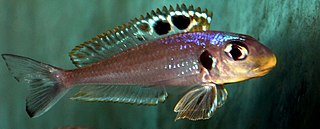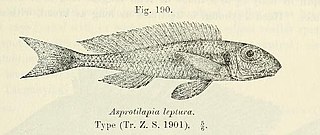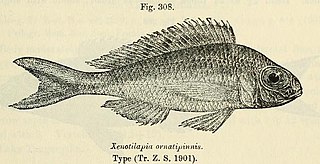
Lake Tanganyika is an African Great Lake. It is the second-oldest freshwater lake in the world, the second-largest by volume, and the second-deepest, in all cases after Lake Baikal in Siberia. It is the world's longest freshwater lake. The lake is shared between four countries – Tanzania, the Democratic Republic of the Congo (DRC), Burundi, and Zambia, with Tanzania (46%) and DRC (40%) possessing the majority of the lake. It drains into the Congo River system and ultimately into the Atlantic Ocean.

Xenotilapia is a genus of cichlids species endemic to Lake Tanganyika in east Africa.

Neolamprologus multifasciatus is one of the small shell-dwelling cichlids endemic to Lake Tanganyika. The male reaches 5 cm (2 in) in length, and the female only 2.5 cm (1 in) in the aquarium. In the wild, they reach only 3 centimetres (1.2 in) in standard length of male and female reaches less than 2.2 centimetres (0.87 in) in standard length. This makes them one of the smallest cichlid species in the world. Its natural habitat is the Neothauma shell beds of Lake Tanganyika, where it forms huge colonies with thousands of individuals. Their unique behavior is associated with their affinity to shells. They burrow sand to move shells, take refuge in shells and also breed in them. They have pale white coloring with black vertical bars running the length of their bodies. The species is sexually monomorphic, meaning sexing individuals is extremely hard or impossible based on external appearance alone.
Labidochromis lividus is a species of cichlid endemic to Lake Malawi where it is only known to occur over rocky substrates along the western coast of Likoma Island. This species can reach a length of 7.1 centimetres (2.8 in) SL. It can also be found in the aquarium trade.

Xenotilapia bathyphila is a species of cichlid endemic to Lake Tanganyika where it occurs in schools in areas with sandy substrates. It feeds on small shrimps and copepods. This species can reach a length of 10.3 centimetres (4.1 in) TL. It can also be found in the aquarium trade.
Xenotilapia boulengeri is a species of cichlid endemic to Lake Tanganyika where it occurs in schools in areas with sandy substrates. Its diet consists of small shrimps and copepods. This species can reach a length of 15.3 centimetres (6.0 in) TL. It can also be found in the aquarium trade. The specific name honours the Belgian-British zoologist George Albert Boulenger (1858-1937), in recognition of his world on the fishes of Lake Tanganyika.
Xenotilapia burtoni is a species of cichlid endemic to Lake Tanganyika where it is only known from areas with sandy substrates in Burton Bay. This species can reach a length of 17.7 centimetres (7.0 in) TL. It can also be found in the aquarium trade.
Xenotilapia caudofasciata is a species of cichlid endemic to Lake Tanganyika where it prefers areas with sandy substrates. This species can reach a length of 10.5 centimetres (4.1 in) TL. It can also be found in the aquarium trade.

The yellow sand cichlid is a species of cichlid endemic to Lake Tanganyika where it is found in schools in areas with sandy substrates. This species can reach a length of 9.2 centimetres (3.6 in) TL. It can also be found in the aquarium trade.

Xenotilapia leptura is a species of cichlid endemic to Lake Tanganyika where it prefers areas with rocky substrates. This species can reach a length of 11 centimetres (4.3 in) TL. It can also be found in the aquarium trade.
Xenotilapia longispinis is a species of cichlid endemic to Lake Tanganyika where it prefers areas with sandy substrates. This species can reach a length of 16.3 centimetres (6.4 in) TL. It can also be found in the aquarium trade.

Xenotilapia melanogenys is a species of cichlid endemic to Lake Tanganyika. This species can reach a length of 15 centimetres (5.9 in) TL. It can also be found in the aquarium trade.
Xenotilapia nasus is a species of cichlid endemic to Lake Tanganyika. This species can reach a length of 9.3 centimetres (3.7 in) TL.

Xenotilapia nigrolabiata is a species of cichlid endemic to Lake Tanganyika where it prefers areas with sandy substrates. This species can reach a length of 13 centimetres (5.1 in) TL. It can also be found in the aquarium trade.
Xenotilapia ochrogenys is a species of cichlid endemic to Lake Tanganyika where it prefers areas with sandy substrates. This species can reach a length of 11 centimetres (4.3 in) TL. It can also be found in the aquarium trade.

Xenotilapia ornatipinnis is a species of cichlid endemic to Lake Tanganyika where it can be found in schools in areas with sandy substrates. This species can reach a length of 12.5 centimetres (4.9 in) TL. It can also be found in the aquarium trade.

Xenotilapia sima is a species of cichlid endemic to Lake Tanganyika where it prefers areas with sandy substrates. This species can reach a length of 16.4 centimetres (6.5 in) TL. It can also be found in the aquarium trade.
Xenotilapia spiloptera is a species of cichlid endemic to Lake Tanganyika where it prefers areas with sandy substrates. This species can reach a length of 9.6 centimetres (3.8 in) TL. It can also be found in the aquarium trade.
Xenotilapia tenuidentata is a species of cichlid endemic to Lake Tanganyika where it is only known from the western shore. This species can reach a length of 8 centimetres (3.1 in) TL. It can also be found in the aquarium trade. Some authorities place this species in the genus Microdontochromis along with Xenotilapia rotundiventralis, with X. tenuidentata as the type species.

Xenotilapia papilio is a species of cichlid endemic to Lake Tanganyika in East Africa. It is found on the western shore of the lake, between Tembwe (Deux) and Kanoni in the Democratic Republic of the Congo. It prefers deeper, rocky habitats, especially where the rocks are covered with sand, at depths from 3–40 m (9.8–131.2 ft).









